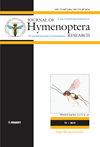Biological and morphological studies on the parasitoids (Hymenoptera, Ichneumonidae) of Aprosthema tardum (Klug) (Hymenoptera, Argidae, Sterictiphorinae) in Var, southern France
IF 1.5
3区 农林科学
Q2 ENTOMOLOGY
引用次数: 1
Abstract
Field surveys at four neighbouring but discrete sites in southern France revealed the presence of five ichneumonid parasitoids of the Lathyrus-feeding sterictiphorine argid sawfly Aprosthema tardum. Four of these parasitoids, Lathrolestes erythrocephalus, Ischyrocnemis goesi (both Ctenopelmatinae), Terozoa quadridens and Thibetoides aprosthemae (both Tryphoninae), could be identified and, by also incorporating laboratory studies, the developmental biology of each was elucidated and illustrated. A little supplementary information from a site in Italy is also presented. The fifth species was detected only once and failed to develop in its cocoon; it remains unidentified but the cephalic sclerites of its final instar larva are illustrated. The identified parasitoids are all more or less rare and little-known species and prior to this study only L. erythrocephalus had a known host; the others were biologically unknown even at the generic level and not recorded from France. The egg of L. erythrocephalus bears prominent hooked structures at its capital end, not reported in other studied Lathrolestes species. From its biology as an endoparasitoid of a sawfly and from larval characters, Ischyrocnemis is confidently assigned to Ctenopelmatinae. Both ctenopelmatines could successfully parasitise the host during any of its 2nd to 5th instars, but the tryphonines were less flexible. Terozoa monitors hosts until the moult to the final instar before ovipositing on them, usually affixing the egg to the head and often an eye (stemma), while Thibetoides parasitises much younger hosts, placing its strongly anchored egg behind a thoracic leg where it remains through successive host moults. Some characters used in the past to determine Terozoa species are discussed, and a new provisional key to the known species of Terozoa is presented. The very different developmental biology of Terozoa and Thibetoides may challenge views that they are closely related genera. Terozoa bituberculata (Constantineanu, 1973), stat. rev. is raised from synonymy with T. quadridens Perkins, 1962. Reinterpretations of several cephalic structures of final instar larvae as well as larval spiracles are discussed, and a new interpretation and terminology for describing the latter is introduced.法国南部瓦尔省夜蛾(approsthema tardum, Klug)寄生蜂(膜翅目,姬蜂科)的生物学和形态学研究
在法国南部四个相邻但不连续的地点进行的实地调查显示,存在五种以杀螨精氨酸锯蝇为食的Lathyrus的伊蚊寄生蜂。这些寄生蜂中的四种,红头Lathrolestes erythrocephalus、戈氏Ischyronemis goesi(均为Ctenoelmatinae)、Terozoa quaddens和Thibetoides aprosthemae(均为Tryphoninae),可以被鉴定出来,并且通过结合实验室研究,阐明和说明了每种寄生蜂的发育生物学。还介绍了来自意大利一个网站的一些补充信息。第五个物种只被发现过一次,未能在茧中发育;它的身份仍然不明,但其最后一龄幼虫的头部巩膜炎已被说明。已确定的寄生蜂都或多或少是罕见和鲜为人知的物种,在本研究之前,只有红头乳杆菌有已知的宿主;其他的在生物学上是未知的,甚至在普通水平上也是未知的,并且没有从法国记录下来。红头乳杆菌的卵在其基端具有突出的钩状结构,这在其他研究的拉脱维亚虫物种中没有报道。从其作为锯蝇内寄生虫的生物学特性和幼虫特征来看,Ischyrocnemis被自信地归类于Ctenoelmatinae。在寄主2至5龄的任何一龄,两种锥虫胺都能成功寄生在寄主上,但锥虫胺的灵活性较差。Terozoa监测宿主,直到蜕皮到最后一龄,然后在它们身上产卵,通常将卵附着在头部,通常是一只眼睛(茎),而Thibetoides寄生在年轻得多的宿主身上,将其牢固固定的卵放在胸腿后面,在连续的宿主蜕皮过程中一直留在胸腿后面。讨论了过去用于确定Terozoa物种的一些特征,并提出了一个新的Terozoa已知物种的临时索引。Terozoa和Thibetoides非常不同的发育生物学可能会挑战它们是密切相关属的观点。Terozoa bituberculata(Constantineanu,1973),stat.rev.是从T.quaddens Perkins的同义词中提出的,1962年。讨论了对末龄幼虫和幼虫螺旋体的几种头部结构的重新解释,并介绍了描述后者的新解释和术语。
本文章由计算机程序翻译,如有差异,请以英文原文为准。
求助全文
约1分钟内获得全文
求助全文
来源期刊
CiteScore
2.60
自引率
15.40%
发文量
68
审稿时长
>12 weeks
期刊介绍:
The Journal of Hymenoptera Research is a peer-reviewed, open-access, rapid online journal launched to accelerate research on all aspects of Hymenoptera, including biology, behavior, ecology, systematics, taxonomy, genetics, and morphology.
All published papers can be freely copied, downloaded, printed and distributed at no charge for the reader. Authors are thus encouraged to post the pdf files of published papers on their homepages or elsewhere to expedite distribution. There is no charge for color.

 求助内容:
求助内容: 应助结果提醒方式:
应助结果提醒方式:


